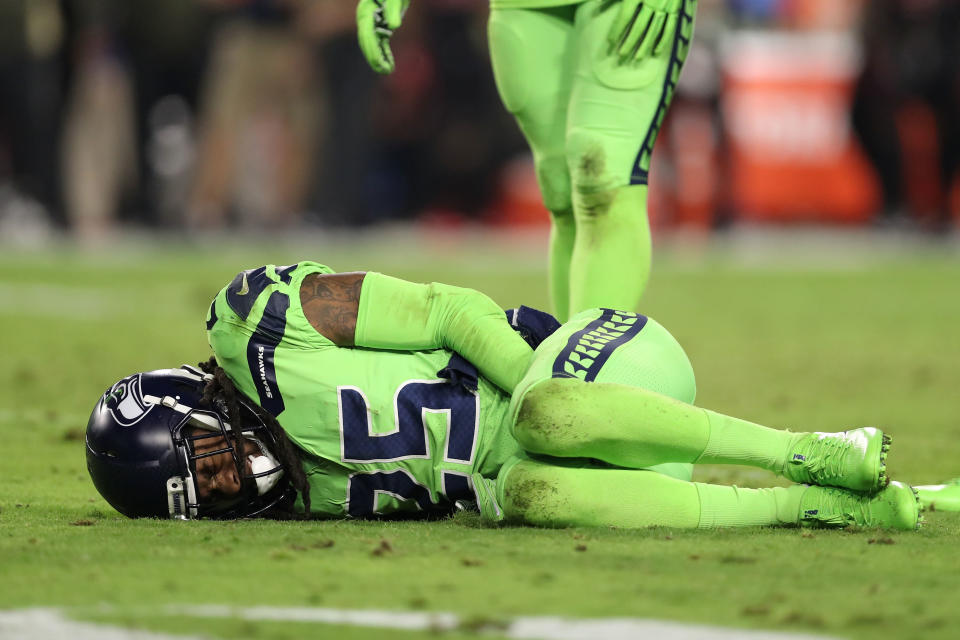With Richard Sherman out, the list of injured NFL stars grows more stunning
It’s a grim joke at this point: if you created a team made up exclusively of injured NFL stars, it’d be the odds-on Super Bowl favorite … for 2018, obviously.
J.J. Watt. Aaron Rodgers. Odell Beckham Jr. David Johnson. Dalvin Cook. Deshaun Watson. Andrew Luck. Joe Thomas. Julian Edelman. Zach Miller. Marshall Yanda. And now, after a Thursday night Achilles tear, Richard Sherman.
For a league reeling from crises both external and self-inflicted, the loss of such star power is a devastating blow. Virtually every fan has lost a key player from their team, whether real or fantasy. And anyone who believes that other stars still upright aren’t playing on borrowed time is fooling themselves.
The NFL has quite a problem on its hands here. For decades, the league has promoted The Shield above any individual player. The Game is the star, this theory goes, not Glory Quarterback X. And for decades, that construct worked just fine; we’d follow players through their career, then bid them farewell as they hobbled off the field, and remember the good ol’ days a couple years later when their number was retired and their jersey hoisted up into their stadium’s ring of honor. But we always came back; where else were we going to go?
But now, the NFL finds itself in an unfamiliar position, facing widespread criticism and falling ratings. Cord-cutting; other entertainment options; falling ratings for TV across the board; and, yes, protests of the protests have all had a depressive effect on the NFL’s popularity. The NFL’s ratings are down 5.5 percent from 2016, which in turn was down from 2015. The anti-protest crowd will take the credit for this, but it’s worth noting that ALL television is down by a similar margin (and the NFL remains the runaway leader in every relevant ratings metric).
But the NFL can spin this like Marshall Newhouse on an attempted runback, and the facts won’t change: down is down, and Brett Hundley vs. Tom Savage isn’t going to reverse that trend. The NFL needs its stars, and it needs them playing.
So what’s to be done? To some extent, these injuries are an inevitable result of the game. When your purpose is to slam into your opponent with enough force to halt their progress and bring them to the ground, catastrophic injuries are a feature, not a bug. But let’s kick around some possible ideas.
1. Do nothing. This would be the preferred stance of many involved with the NFL, both in the front office and the stands. Many fans view NFL players as disposable puppets here for their entertainment, a stance NFL commissioner Roger Goodell essentially underlined this week by saying that “people come to our stadiums to be entertained and have fun, not to be protested to.” Get rid of those pesky protests and play football, this reasoning goes, and if you get injured, hey, you knew the risks going in, millionaire.
2. Ditch, or cut back, Thursday Night Football. TNF is Exhibit A in the NFL oversaturation theory, that too much football isn’t necessarily a good thing. But the NFL’s requirement that each team get national exposure leads to crappy matchups, and short prep time weeks lead to poor gameplay and, in some cases, added injury. While the complete elimination of TNF isn’t likely, perhaps a reduced schedule, say once a month, could give the game the marquee status the NFL believes it deserves.
3. Add a second week of byes. Adding an 18th week to the football schedule without adding another game would give players a chance to heal up. And if the NFL is determined to keep Thursday night games after the expiration of TV contracts in 2021, adding an extra bye week could allow schedulers to give teams with Thursday night games the week off beforehand, preventing a three-games-in-fifteen-days scenario.
4. In-game modifications. Old-school football fans and players already complain that the game is too much like two-hand touch, but old-schoolers complain about everything. The problem with in-game modifications is that we’re already in an overregulated environment, with teams averaging between four (Carolina) and 10 (Seattle) penalties per game. Further altering a game where violence is an essential function, not a byproduct, will only lead to a blizzard of yellow flags.
5. Guaranteed contracts. Alone among the major sports, the NFL doesn’t routinely offer guaranteed contracts. This is where the whole “NFL players are spoiled millionaires” trope falls apart; the average NFL career lasts less than three years, and as few as 15 percent of players collect on the totality of those gargantuan eight-figure contract deals agents love to plant in the press. There are plenty of reasons why NFL players don’t have guaranteed contracts—this Deadspin article from August is an excellent rundown—but ironically enough, injury is a key reason. Owners don’t want to guarantee money to a player who might get their femur shoved through their pelvis in Week 1. But it’s up to the Players’ Association, and the NFL itself, to flip that: guaranteed contracts would incentivize owners to push for more safety to protect their investments. Again, “that’s the way we’ve always done it” is no longer a valid mantra.
The NFL’s in an existential crisis right now, and it’s long past time where the league can afford to trundle along merrily and assume numbers will stay high just because they always have. Decades of slow drift have put the NFL in a suddenly precarious position, and it’ll take some real vision to pilot the league out of it.
And stars, too. Stars would help a whole lot.

____
Jay Busbee is a writer for Yahoo Sports and the author of EARNHARDT NATION, on sale now at Amazon or wherever books are sold. Contact him at jay.busbee@yahoo.com or find him on Twitter or on Facebook.



